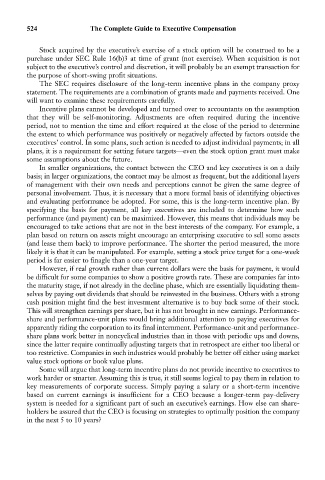Page 538 - Bruce Ellig - The Complete Guide to Executive Compensation (2007)
P. 538
524 The Complete Guide to Executive Compensation
Stock acquired by the executive’s exercise of a stock option will be construed to be a
purchase under SEC Rule 16(b)3 at time of grant (not exercise). When acquisition is not
subject to the executive’s control and discretion, it will probably be an exempt transaction for
the purpose of short-swing profit situations.
The SEC requires disclosure of the long-term incentive plans in the company proxy
statement. The requirements are a combination of grants made and payments received. One
will want to examine these requirements carefully.
Incentive plans cannot be developed and turned over to accountants on the assumption
that they will be self-monitoring. Adjustments are often required during the incentive
period, not to mention the time and effort required at the close of the period to determine
the extent to which performance was positively or negatively affected by factors outside the
executives’ control. In some plans, such action is needed to adjust individual payments; in all
plans, it is a requirement for setting future targets—even the stock option grant must make
some assumptions about the future.
In smaller organizations, the contact between the CEO and key executives is on a daily
basis; in larger organizations, the contact may be almost as frequent, but the additional layers
of management with their own needs and perceptions cannot be given the same degree of
personal involvement. Thus, it is necessary that a more formal basis of identifying objectives
and evaluating performance be adopted. For some, this is the long-term incentive plan. By
specifying the basis for payment, all key executives are included to determine how such
performance (and payment) can be maximized. However, this means that individuals may be
encouraged to take actions that are not in the best interests of the company. For example, a
plan based on return on assets might encourage an enterprising executive to sell some assets
(and lease them back) to improve performance. The shorter the period measured, the more
likely it is that it can be manipulated. For example, setting a stock price target for a one-week
period is far easier to finagle than a one-year target.
However, if real growth rather than current dollars were the basis for payment, it would
be difficult for some companies to show a positive growth rate. These are companies far into
the maturity stage, if not already in the decline phase, which are essentially liquidating them-
selves by paying out dividends that should be reinvested in the business. Others with a strong
cash position might find the best investment alternative is to buy back some of their stock.
This will strengthen earnings per share, but it has not brought in new earnings. Performance-
share and performance-unit plans would bring additional attention to paying executives for
apparently riding the corporation to its final internment. Performance-unit and performance-
share plans work better in noncyclical industries than in those with periodic ups and downs,
since the latter require continually adjusting targets that in retrospect are either too liberal or
too restrictive. Companies in such industries would probably be better off either using market
value stock options or book value plans.
Some will argue that long-term incentive plans do not provide incentive to executives to
work harder or smarter. Assuming this is true, it still seems logical to pay them in relation to
key measurements of corporate success. Simply paying a salary or a short-term incentive
based on current earnings is insufficient for a CEO because a longer-term pay-delivery
system is needed for a significant part of such an executive’s earnings. How else can share-
holders be assured that the CEO is focusing on strategies to optimally position the company
in the next 5 to 10 years?

